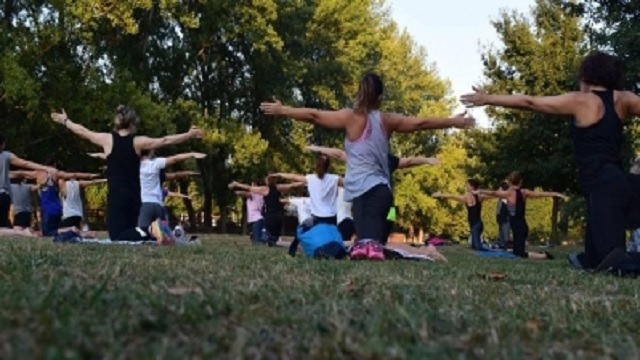This March was the first in-person lecture series offered at Body Logic Physical Therapy. There will be a thirty to forty minute lecture followed by a Q&A each month for the rest of the year. Check our website for dates, times and topics. The topic of the March 7 conference was “Demystifying: What are the most common myths about the treatment of chronic low back pain?” »
Since back pain and exercise is always a hot topic, and I touched on this topic in my talk, I thought I’d start by revisiting this belief that people with back pain can be cured or repaired with exercise.
First, for a tiny percentage of people with low back pain, there is no cure for chronic low back pain. The term “cure” should be replaced with “self-management” of low back pain for this subgroup.
Self-management of chronic low back pain is very effective and can be achieved with a combination of tools. There are several different exercises, stretching techniques, meditation, diet, and many other mind-body integration wellness strategies that can help reduce chronic low back pain. Physical therapists use a wide variety of exercises to help manage chronic low back pain. There are exercises to strengthen weak muscles, lengthen or stretch tight muscles, help coordinate spinal stability, and many exercises or techniques designed to relieve pain. Physical therapists like to use the word exercise and home exercise program to include these concepts.
Exercise alone does not prevent or eliminate chronic low back pain sufferers. Many researches have shown that most people with back pain exercise regularly and that their exercises do not eliminate the pain. Research has shown that this subset of chronic low back pain sufferers are typically hypervigilant in everything they do. They keep the trunk (core) muscles “activated”, hoping that keeping a stiff spine will help eliminate frequent pain throughout the day. This thinking is wrong. The excessive co-contraction of the trunk muscles causes a load on the spine. This load makes the structures of the back (muscles, ligaments and bones) more sensitive, which causes more pain.
Imagine holding your fist tight all day, then when you go to use your hand to grab a cup of coffee, it causes pain and makes you feel weak, tired, and stiff. The thought at this point is to do what? Yeah, strengthen the wrist if it feels vulnerable, right?
Wrong. The evidence shows that it hasn’t worked in the past and won’t work in the future. Now for the good news regarding this group of back pain sufferers.
Research on people with chronic low back pain
Over the past decade, a group of researchers from Curtin University in Western Australia have studied this subgroup of patients with chronic low back pain. They conducted a series of randomized controlled trials. The studies took place in three countries (Australia, UK and Norway). One group (control group) received the standard treatment of physiotherapy-prescribed exercises to strengthen the back, information on protecting the back with stabilization exercises, and training in body mechanics for heavy lifting. The second group (experimental group) received instructions on how to move their backs with full spinal range of motion and instructed patients on how to relax their abdominal muscles with all activities. The researchers told the patients to stop co-contracting the core muscles with whatever they were doing and to spend more time helping them dispel their belief system that their back was weak, the discs were getting worse. were wearing out and their backs could break down and crumble at any moment. They showed them proof that our backs are a strong, sturdy structure that can take a lot of abuse and still function perfectly. They quickly understood that a back injury, such as a sprained ankle, could be treated. A day or two of rest, ice, and some anti-inflammatories, then back to movement, exercise, and resuming all activities have been shown to be effective. Expect a few days to a week to regain full activity.
These patients were followed and measured at four intervals (three, six, nine and 12 months) over an entire year.
The results were shocking. The experimental group demonstrated marked improvements in every measure. They had less pain overall, improved function, most returned to full-time work, and all returned to activities that were painful and frightening to them a year earlier. They stopped protecting their backs, and their backs are better, much better. They relaxed their abdominal muscles by sitting down, lifting and doing almost everything. They sat in slumped chairs with spines completely relaxed and enjoyed their exercises without co-contraction of core muscles. They felt looser and had more energy. The subjects in the experimental group realized that there was time to exercise and strengthen the core muscles as hard as they could, and then there was time to fully relax.
The control group demonstrated minimal improvements. The authors’ conclusion over a decade of working on these three studies is that people with back pain believe that tightening their abs to do something strenuous is the right way to protect the spine. Even when these beliefs caused pain, they found that the more people suffered, the harder they worked and the more they suffered. The exciting pattern with these chronic low back pain patients was their belief in keeping their core muscles activated even when they were sitting and eating a meal, watching television, or at their workstation. It became a vicious cycle of pain-tightening the muscles-more pain-tightening the muscles. Research has demonstrated that the perpetual co-contraction of abdominal and back muscles creates massive loads on spinal structures, as hypothesized.
This exciting phenomenon may not be the case for many readers of this column. Most of you reading this may even have had lower back pain in the past, and a series of core-strengthening exercises have given you the tools to manage your pain. Phil Carville wrote about this concept last month. However, if you have a spouse, friend, or co-worker who has had lower back pain for many years, exercises regularly, and sees many providers, they may be a candidate for physical therapy. Physiotherapy will treat their pain by looking closely at their habits and beliefs and challenging these ideals with a physiotherapist who will distinguish fact from fiction. These researchers called this approach in the management of chronic low back pain patients cognitive functional therapy. Cognitive Functional Therapy has become common knowledge in many physical therapy clinics across the country and the world.
The evidence is clear that exercise is beneficial for people with back pain. If you haven’t exercised, start a program supervised by your physical therapist or trainer. If exercise causes you pain, consult your physiotherapist and they will help you identify exercises, movements or daily habits that could be causing your pain. Finally, your exercise routine should leave you feeling refreshed, invigorated, and ready to take on the world. You shouldn’t feel battered, sore, achy, or have lower back pain. Enjoy your exercise.
John Seivert is a Doctor of Physiotherapy and has been practicing for 34 years. He opened Body Logic physical therapy in Grass Valley in 2001. He has been training physical therapists since 1986. Contact him at [email protected]
Getty Images
 AD Roberts
AD Roberts



